Blog
Fast and Furious
China’s State Council decided last month to lower the cap on sulfur content in gasoline and diesel for on-road vehicles to 10 parts per million (ppm) in 2016. This is a huge leap for a country whose vast vehicle fleet only a few years ago was still burning diesel fuel containing 35 times that much sulfur. Since 2011 Beijing’s “airpocalypses” have captured popular attention and catalyzed support for improving fuel quality. The persistently high levels of particulate pollution in major Chinese cities provoked growing criticism of the government. The concern about air quality, and rising public discontent, finally led the national government to take the dramatic step of chopping fuel sulfur content to levels as low as anywhere in the globe. To China watchers, this is not surprising. Many harbor the view that if the Chinese government wants something badly enough, it can act with a rapidity that few other governments can match.
Ship owners should take note. Having slashed sulfur content for on-road diesel fuel, China’s policymakers are likely to switch their attention to other sources of particulate pollution. With the official international limit on sulfur content of marine fuel still at an eye-popping 35,000 ppm, the shipping industry could be an inviting target. Even though the current average sulfur level for heavy fuel oil has dropped to 25,000 ppm, and will fall to 5,000 ppm by 2020 (pending an International Maritime Organization technical review), that rate of progress is frustratingly slow by Chinese standards.
Policymakers in China have a case, too. Seven of the world’s ten largest ports are in China, and these port cities happen to be the most populous and economically prosperous metropolises. These are densely settled places, and shipping emissions from port activity happens in the midst of residential and commercial districts (see this photo of Hong Kong, for example). In 2013, PM emissions from ocean-going vessels (OGVs) accounted for over a third of total emissions from mobile sources in China, a consequence of poor quality marine fuel. In Hong Kong, ships accounted for more than a third of total PM emissions in the city (see Chart 2). The PM10 emissions that a midsize container ship churns out one day equals emissions from more than 7,000 passenger vehicles for an entire year.

Hong Kong skyline. (Photo Mike Behnken, Flickr; source.)
Momentum for change is building. Hong Kong has received lawmakers’ blessing to implement a mandatory low-sulfur fuel rule for all OGVs hoteling at the port. A neighboring city, Shenzhen, has instituted a fuel-switching subsidy for ships visiting the port. Other cities, spurred by a new, more rigorous ambient air quality standard for fine particulates, are scoping out plans to reduce emissions from their own ports. We have a hand in this as well. ICCT has signed a Memorandum of Understanding with the Shenzhen government to help them tally emissions from varying sources around the port. Nationally, ICCT has been collaborating with the Vehicle Emission Control Center (VECC) to calculate an emissions inventory from OGVs in the country, which would lay the groundwork for integrating shipping into the next five-year plan. Another project that ICCT has been working on with VECC is to explore a better approach to enforcing emission-reducing regulations. Adding teeth to regulation will boost public confidence and reward companies in compliance.
So what should ship owners do? They can either resist change or participate in the policymaking process and shape it from inside. Indeed, the most successful businesses always look a few steps ahead. Maersk, for example, turned low-sulfur fuel regulation in California to its advantage a decade ago and established itself as a beacon for environmental stewardship in the shipping business. Given the Chinese government’s resolute and speedy effort to solve its air-quality problems, others in the shipping industry would be well-served to follow that example.

